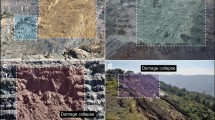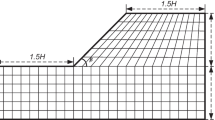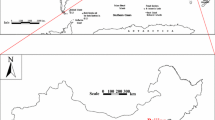Abstract
The strength reduction method is a suitable numerical method for analysing the stability of complex rock slopes. However, in the determination of the safety factor of a slope, a critical limitation to this approach is the definition of the critical (or limit equilibrium) state of the slope. To overcome this problem, the analysis of the development of the crack tip plastic zone for preexisting cracks in a fractured rock slope is used as the basis for a proposed new method that defines the critical state of the slope by considering mesoscale failure. Thus, using the eXtended Finite Element Method as a tool and based on this new definition, a new strength reduction numerical method to analyse the stability of a fractured rock slope is proposed. Finally, the new method is verified by performing a comparison with the traditional strength reduction method for the numerical study of a rock slope that has four unequal preexisting cracks. The results show that a value of 0.3 for the ratio of the crack space to the short crack length can be considered the new definition of the critical state for a slope. Furthermore, because mesoscale failure appears before macroscale failure, the safety factor corresponding to the new method is smaller than that derived by the traditional method, which considers macroscale failure. Therefore, the proposed method is beneficial for engineering safety.


















Similar content being viewed by others
References
Alejano LR, Ferrero AM, Ramírez-Oyanguren P, Álvarez-Fernández MI (2011) Comparison of limit-equilibrium, numerical and physical models of wall slope stability. Int J Rock Mech Min Sci 48:16–26
Ayatollahi MR, Pavier MJ, Smith DJ (2002) Mode-I cracks subjected to large T-stresses. Int J Fract 117:159–174
Belytschko T, Moes N, Usui S, Parimik C (2001) Arbitrary discontinuities in finite elements. Int J Numer Methods Eng 50:993–1013
Bonilla-Sierra V, Scholtès L, Donzé F, Elmouttie M (2015) DEM analysis of rock bridges and the contribution to rock slope stability in the case of translational sliding failures. Int J Rock Mech Min Sci 80:67–78
Brideau MA, Yan M, Stead D (2009) The role of tectonic damage and brittle rock fracture in the development of large rock slope failures. Geomorphology 103:30–49
Camones LAM, Vargas EA Jr, Figueiredo RP, Velloso RQ (2013) Application of the discrete element method for modeling of rock crack propagation and coalescence in the step-path failure mechanism. Eng Geol 153:80–94
Chen T, Deng JH, Sitar N, Zheng J, Liu TX, Liu AJ, Zheng Lu (2017) Stability investigation and stabilization of a heavily fractured and loosened rock slope during construction of a strategic hydropower station in China. Eng Geol 221:70–81
Cheng YM, Lansivaara T, Wei WB (2007) Two-dimensional slope stability analysis by limit equilibrium and strength reduction methods. Comput Geotech 34:137–150
Dawson EM, Roth WH, Drescher A (1999) Slope stability analysis by strength reduction. Géotechnique 49(6):835–840
Fu WX, Liao Y (2010) Non-linear shear strength reduction technique in slope stability calculation. Comput Geotech 37:288–298
Frankovská J, Kopecký M, Panuška J, Chalmovský J (2015) Numerical Modelling of Slope Instability. Proc Earth Planet Sci 15:309–314
Gross D, Seelig T (2011) Fracture mechanics. Springer, Heidelberg
Jiang QH, Qi ZF, Wei W, Zhou CB (2015) Stability assessment of a high rock slope by strength reduction finite element method. Bull Eng Geol Environ 74:1153–1162
Jiang QQ (2009) Strength reduction method for slope based on a ubiquitous-joint criterion and its application. Min Sci Technol 19:452–456
Kirschbaum DB, Adler R, Hong Y, Hill S, Lerner-Lam A (2010) A global landslide catalog for hazard applications: method, results, and limitations. Nat Hazards 52:561–575
Liu YQ, Li HB, Xiao KQ, Li JC, Xia X, Liu B (2014) Seismic stability analysis of a layered rock slope. Comput Geotech 55:474–481
Maji VB (2017) An insight into slope stability using strength reduction technique. J Geol Soc India 89:77–81
Maji VB, Sivakumar G (2018) Crack initiation-propagation and failure modes in rocks. In: Krishna AM, Dey A, Sreedeep S (eds) Geotechnics for natural and engineered sustainable technologies. Springer, Singapore, pp 317–328
Scholtès L, Donzé FV (2015) A DEM analysis of step-path failure in jointed rock slopes. CR Mec 343:155–165
Stead D, Wolter A (2015) A critical review of rock slope failure mechanisms: the importance of structural geology. J Struct Geol 74:1–23
Stolarska M, Chopp DL, Moes N, Belyschko T (2001) Modeling crack growth by level sets in the extended finite element method. Int J Numer Methods Eng 51:943–960
Sun CW, Chai JR, Xu ZG, Qin Y, Chen XZ (2016) Stability charts for rock mass slopes based on the Hoek–Brown strength reduction technique. Eng Geol 214:94–106
Tang SB (2015) The effect of T-stress on the fracture of brittle rock under compression. Int J Rock Mech Min Sci 79:86–98
Tang SB, Bao CY, Liu HY (2017) Brittle fracture of rock under combined tensile and compressive loading conditions. Can Geotech J 54(1):88–101
Tang SB, Huang RQ, Tang CA, Liang ZZ, Heap MJ (2017) The failure processes analysis of rock slope using numerical modelling techniques. Eng Fail Anal 79:999–1016
Wong LNY, Wu ZJ (2014) Application of the numerical manifold method to model progressive failure in rock slopes. Eng Fract Mech 119:1–20
Xi JY, Chen ZH, Zhang W (2014) Fracture mechanics analysis of unequal cracks interaction under uniaxial tension. Chin J Rock Mech Eng 33(s2):3625–3630 (in Chinese)
Yao WM, Hu B, Ma C, Zhan HB (2017) Applicability research on the dip slope with interbeddings of weak and strong rocks using strength reduction method. Geotech Geol Eng 35:1111–1118
You G, Mandalawi MA, Soliman A, Dowling K, Dahlhaus P (2018) Finite element analysis of rock slope stability using shear strength reduction method. In: Frikha W, Varaksin S, Fonseca AV (eds) Soil testing, soil stability and ground improvement. Springer, Cham, pp 227–235
Zhang K, Cao P, Meng JJ, Li KH, Fan WC (2015) Modeling the progressive failure of jointed rock slope using fracture mechanics and the strength reduction method. Rock Mech Rock Eng 48:771–785
Zheng H, Sun GH, Liu DF (2009) A practical procedure for searching critical slip surfaces of slopes based on the strength reduction technique. Comput Geotech 36:1–5
Zheng YR, Shen ZJ, Gong XN (2002) Generalized plastic mechanics—the principles of geotechnical plastic mechanics. China Architecture and Building Press, Beijing (in Chinese)
Zhou XP, Chen JW (2019) Extended finite element simulation of step-path brittle failure in rock slopes with non-persistent en-echelon joints. Eng Geol 250:65–88
Zienkiewicz OC, Humpheson C, Lewis RW (1975) Associated and nonassociated viscoplasticity in soil mechanics. Géotechnique 25(4):671–689
Acknowledgements
This work was supported by the National Natural Science Foundation of China [Grant Number 41831278] and the Fundamental Research Funds for the Central Universities [Grant Number 2016B10214].
Author information
Authors and Affiliations
Corresponding author
Additional information
Publisher's Note
Springer Nature remains neutral with regard to jurisdictional claims in published maps and institutional affiliations.
Rights and permissions
About this article
Cite this article
Gao, W., Chen, X., Wang, X. et al. Novel strength reduction numerical method to analyse the stability of a fractured rock slope from mesoscale failure. Engineering with Computers 37, 2971–2987 (2021). https://doi.org/10.1007/s00366-020-00984-2
Received:
Accepted:
Published:
Issue Date:
DOI: https://doi.org/10.1007/s00366-020-00984-2




